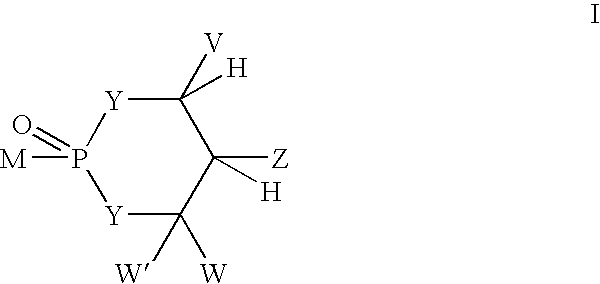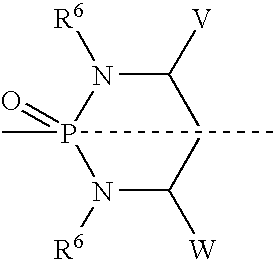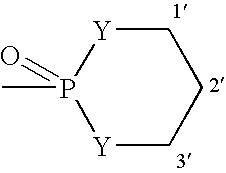Prodrugs for liver specific drug delivery
a liver and drug delivery technology, applied in the direction of drug compositions, group 5/15 element organic compounds, metabolism disorders, etc., can solve the problems of limited carrier manufacturing and drug loading, poor oral bioavailability of drug-protein conjugates, and poor pharmacological effect, so as to prolong the pharmacodynamic half-life of drugs, enhance oral drug delivery, and enhance drug distribution
- Summary
- Abstract
- Description
- Claims
- Application Information
AI Technical Summary
Benefits of technology
Problems solved by technology
Method used
Image
Examples
example 1
General Procedure for Formation of Etoposide Prodrugs
[0513] To a solution of 1(4-pyridyl)-propane-1,3-diol (321 mg, 2.1 mmol) (prepared as in Example 5) in dichloromethane (20 mL) was added phosphorus trichloride at 0° C. The reaction was warmed to room temperature and allowed to stir for 3 h. Reaction mixture was concentrated, azeotroped with toluene (2×10 mL) and dried. The crude chlorophospholane was used in the next step without further purification.
[0514] To a solution of etoposide (250 mg. 0.42 mmol) in DMF (10 mL) was added diisopropylethylamine (1.09 mL, 6.3 mmol) at −40° C. To this mixture was added crude cyclic chlorophospholane (455 mg, 2.1 mmole) in 2 mL of DMF. The mixture was warmed to room temperature and stirred for 2 h. The reaction was cooled back to −40° C. and 5-6M t-butylhydroperoxide in decane (0.84 mL, 4.2 mmol) was added and left at room temperature overnight. The reaction was concentrated and crude mixture was chromatographed by eluting with 5% methanol-di...
example 2
General Procedure for the Formation of Doxorubicin Prodrugs
Step A:
[0516] A mixture of 1.201 g (7.9 mmol) of (R)-1-phenyl-1,3-propanediol and 50 mL of CH2Cl2 was heated to reflux and a solution of POCl3 (0.8 mL, 8.6 mmol) in 50 mL of CH2Cl2 was added dropwise. After the addition was complete, the mixture was heated to reflux for further 3 h. The reaction mixture was poured over a mixture of ice and saturated sodium bicarbonate solution. The organic phase was separated, rinsed with water and saturated sodium chloride and dried over MgSO4. Evaporation of the solvent left a white semisolid, which was treated with ether. The white precipitate formed was filtered, rinsed with more ether and dried under vacuum at room temperature to get 767 mg (42%) of product as a white solid.
Step B: Reaction of Doxorubicin With Cyclic Phosphochloridate
[0517] A mixture of doxorubicin hydrochloride (58.5 mg, 0.10 mmol), phosphorylating agent (26.7 mg, 0.12 mmol) and diisopropylethylamine (45.5 μL, 0....
example 3
General Procedure for Formation of Camitothecin Prodrugs
[0519] To a solution of 1(4-pyridyl)-propane-1,3-diol (1 mmol) in dichloromethane (10 mL) is added phosphorus trichloride at 0° C. The reaction is warmed to room temperature and allowed to stir for 3 h. Reaction mixture is concentrated, azeotroped with toluene (2×10 mL) and dried. Crude chlorophospholane is used in next step without further purification.
[0520] To a solution of camptothecin (1 mmol) in DMF (10 mL) is added diusopropylethylamine (2 mmol) at −40 ° C. To this mixture is added crude cyclic chlorophospholane (1 mmole) in 2 mL of DMF. The mixture is warmed to room temperature and stirred for 2 h. The reaction is cooled back to −40 ° C. and 5-6M t-butylhydroperoxide in decane (2 mmol) is added and left at room temperature. After overnight stirring, the reaction is concentrated and the crude mixture is chromatographed.
PUM
 Login to View More
Login to View More Abstract
Description
Claims
Application Information
 Login to View More
Login to View More - R&D
- Intellectual Property
- Life Sciences
- Materials
- Tech Scout
- Unparalleled Data Quality
- Higher Quality Content
- 60% Fewer Hallucinations
Browse by: Latest US Patents, China's latest patents, Technical Efficacy Thesaurus, Application Domain, Technology Topic, Popular Technical Reports.
© 2025 PatSnap. All rights reserved.Legal|Privacy policy|Modern Slavery Act Transparency Statement|Sitemap|About US| Contact US: help@patsnap.com



